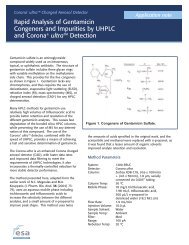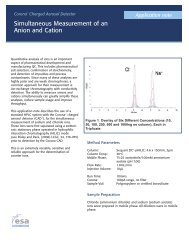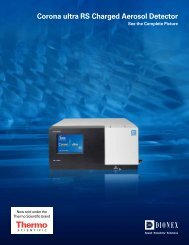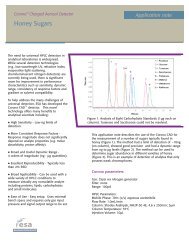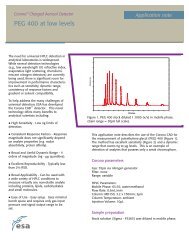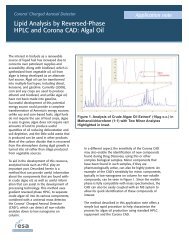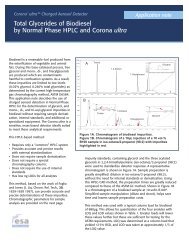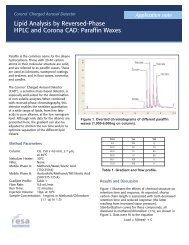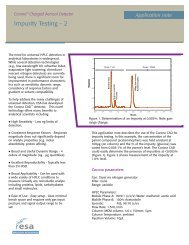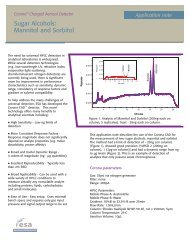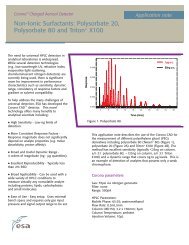Thermo Scientific Dionex Corona ultra RS Charged Aerosol Detector
Thermo Scientific Dionex Corona ultra RS Charged Aerosol Detector
Thermo Scientific Dionex Corona ultra RS Charged Aerosol Detector
Create successful ePaper yourself
Turn your PDF publications into a flip-book with our unique Google optimized e-Paper software.
Application solutions<br />
Pharmaceutical Analysis<br />
Product Characterization<br />
The <strong>Corona</strong> <strong>ultra</strong> <strong>RS</strong> detector makes it easy to<br />
determine the concentration and purity of any<br />
non- and many semivolatile active pharmaceutical<br />
ingredients (APIs) and excipients. With response<br />
independent of the chemical nature of the<br />
analyte, almost any API or compound used<br />
in the formulation can be measured with<br />
predictable response.<br />
28<br />
DL-Leucine<br />
D-Phenylalanine<br />
Typical Pharmaceutical Agents<br />
5 overlaid concentrations from 11–170 ng<br />
Acetaminophen<br />
Theophylline<br />
-2.8<br />
0.12 1 2 3 3.95<br />
Minutes<br />
Erythromycin<br />
Naproxen Na<br />
Diclofenac Na<br />
Dodecylsulfate Na<br />
Progestrone<br />
Using the unique <strong>Thermo</strong> <strong>Scientific</strong> Acclaim <br />
Trinity P1 column and the <strong>Corona</strong> <strong>ultra</strong> <strong>RS</strong><br />
detector, the API, counterion, and impurity<br />
ions can all be quantified, simultaneously. This<br />
speeds up selection of counterions in the<br />
development process.<br />
10.5<br />
Sodium<br />
API and Counterions<br />
Chloride<br />
Diclofenac<br />
0.15% Chloride Spike<br />
0.1% Chloride Spike<br />
No Spike<br />
-5<br />
0 1 2 3 4 5<br />
Minutes<br />
Cleaning Validation<br />
Cleaning validation can be both difficult and time<br />
consuming. Using the <strong>Corona</strong> <strong>ultra</strong> <strong>RS</strong> detector, it<br />
is possible to measure the API and cleaning agents,<br />
either separately or together, as well as estimate<br />
their relative amounts. A profile representing the<br />
relative amounts of cleaning agent can be<br />
generated even without knowing the identity<br />
of the components.<br />
110<br />
–10<br />
Typical Cleaning Agent<br />
0 1.3 2.5 3.8 5.0 6.3 7.5 8.8 10.0<br />
Minutes<br />
10



